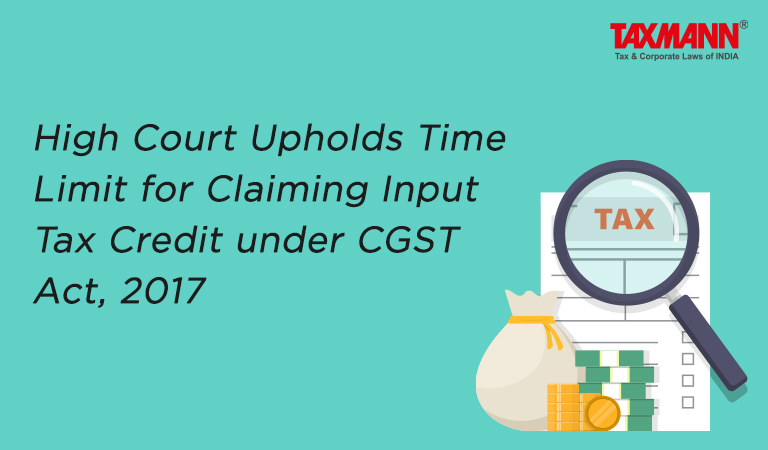High Court Upholds Time Limit for Claiming Input Tax Credit under CGST Act, 2017
- Blog|News|GST & Customs|
- 2 Min Read
- By Taxmann
- |
- Last Updated on 29 July, 2023

Case Details: Thirumalakonda Plywoods v. Assistant Commissioner - State Tax, Circle-1 - [2023] 152 taxmann.com 640 (Andhra Pradesh)
Judiciary and Counsel Details
-
- U. Durga Prasad Rao & T. Mallikarjuna Rao, JJ.
-
Rama Krishna Kumar Potturi for the Petitioner.
Facts of the Case
In the present petition, the validity of Section 16(4) of CGST Act, 2017 which imposed time limit for claiming Input Tax Credit (ITC) was challenged. It was submitted by the petitioner that once returns were accepted with late fees then ITC can’t be denied. It was further contended that this section violated Article 14, Article 19(1)(g) and Section 300-A of Constitution of India since ITC is a statutory right which an assessee is entitled to claim and this section placed stumbling blocks by way of imposing time limit.
High Court Held
The Honorable High Court noted that ITC is a mere concession/rebate/benefit, and not a statutory or constitutional right. The imposing conditions including time limitation for availing said concession would not amount to violation of constitution or any statute. Thus, it was held that the time limit prescribed for claiming ITC under section 16(4) of APGST Act/CGST Act, 2017 is not violative of Article 14, Article 19(1)(g) and Section 300-A of Constitution of India.
The Court also noted that the collection of late fee is only for purpose of admitting returns for verification of taxable turnover of petitioner and mere filing of return with a delay fee would not act as a springboard for claiming ITC if such ITC was claimed beyond the prescribed time limits.
List of Cases Reviewed
-
- Jayam and Co. v. Assistant Commissioner 2016 (15) SCC 125 = [MANU/SC/0956/2016] (para 25)
- USA Agencies v. The Commercial Tax Officer 2013 (5) CTC 63 (para 25)
- ALD Automotive (P.) Ltd. v. Commercial Tax Officer (2019) 13 SCC 225 (para 25)
- Willowood Chemicals (P.) Ltd. v. Union of India 2018 SCC OnLine Guj. 4833 (para 25)
- State of Tamil Nadu v. K. Shyam Sunder (2011) 8 SCC 737 (para 25) followed.
- Graintoch Industries Ltd. v. Commissioner of C. EX, Aurangabad 2014 (310) E.L.T 812 (Tri. – Mumbai)(para 26)
- Sr. Post Master v. Commissioner of C. EX. & S.T. Bolpur 2016 (42) S.T.R. 542 (Tri. – Kolkata) (para 26)
- Candid Security Services v. Commissioner of C. EX. & S.T., Raipur 2019 (28) G.S.T.L. 281 (Tri. – Delhi) (para 26)
- Electic Developers Ltd. v. Commissioner of Central Excise, Goa. 2019 (24) G.S.T.L. 459 (Tri – Mumbai) (para 26) distinguished.
Disclaimer: The content/information published on the website is only for general information of the user and shall not be construed as legal advice. While the Taxmann has exercised reasonable efforts to ensure the veracity of information/content published, Taxmann shall be under no liability in any manner whatsoever for incorrect information, if any.

Taxmann Publications has a dedicated in-house Research & Editorial Team. This team consists of a team of Chartered Accountants, Company Secretaries, and Lawyers. This team works under the guidance and supervision of editor-in-chief Mr Rakesh Bhargava.
The Research and Editorial Team is responsible for developing reliable and accurate content for the readers. The team follows the six-sigma approach to achieve the benchmark of zero error in its publications and research platforms. The team ensures that the following publication guidelines are thoroughly followed while developing the content:
- The statutory material is obtained only from the authorized and reliable sources
- All the latest developments in the judicial and legislative fields are covered
- Prepare the analytical write-ups on current, controversial, and important issues to help the readers to understand the concept and its implications
- Every content published by Taxmann is complete, accurate and lucid
- All evidence-based statements are supported with proper reference to Section, Circular No., Notification No. or citations
- The golden rules of grammar, style and consistency are thoroughly followed
- Font and size that’s easy to read and remain consistent across all imprint and digital publications are applied



 CA | CS | CMA
CA | CS | CMA
